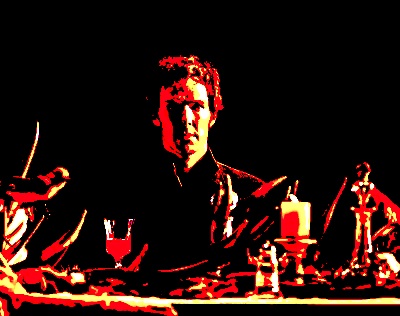 At the urging of my friend, veteran theater-goer Bruce Bratton, I reserved a ticket to a recent HD simulcast of the National Theater production of Hamlet. The one with Benedict Cumberbatch as Hamlet.
At the urging of my friend, veteran theater-goer Bruce Bratton, I reserved a ticket to a recent HD simulcast of the National Theater production of Hamlet. The one with Benedict Cumberbatch as Hamlet.
I had seen the production exactly one month ago, live, in London. (See my review in an earlier post.)
It was interesting to compare the two experiences. And so here’s a taste.
Cutting to the chase, I hugely enjoyed both experiences (although nothing can capture the excitement of the first time). And yet they played out differently in some important ways.
As if they’d read my thoughts, some supporting characters—notably Claudius, Gertrude, and Polonius—were clearer, more nuanced in the performance that was filmed ten days after the performance I saw in London.
Or was it the camera? In close-ups, Ciaran Hinds (Claudius) seemed on deeper acquaintance with his character and proved both moving and persuasive as he bitterly regretted any hope of salvation. The opening sequences, in which Hamlet discovers the horrible truth from the ghost of his father, roiled with power and shock, again because the close-up camera allowed captured the physical intelligence of the actors. The tendons of the neck, flexing of arm muscles, the least twitch of facial features—all seemed to release the inner drama in ways that must, given theater architecture, go un-seen in live performance.
And I must admit that being able to watch Cumberbatch closely, as he propelled his Hamlet through an athletic vocabulary of emotions, face reddening with rage, hair beaded with sweat, allowed the viewer to appreciate all the more the actor’s spectacular sensitivity to his words, his character, and his complete command of dramatic powers.
The high definition camera located each minute facial gesture, allowing us to appreciate Cumberbatch’s skill all the more. We were able to climb onto the stage and inside his outrage—the “frailty, thy name is woman” speech was delivered in suddenly illuminating cadences. And the great “to be or not to be,” with the emphasis placed so as to open up the prince’s dilemma afresh—”that IS the question”—delivered this potent bit of self-analysis with bracing freshness.
That said, I have to kvetch about the intrusion of the camera as a “director” of both my gaze and attention. The camera comes in so closely that all we are allowed to see are one or two actors at a time, for example, Rosenkranz and Guidenstern. We are robbed of the sense of the whole, the panorama of the play which continues on both sides of these two characters. Thanks to the insistent cropping by close camerawork, the viewer was denied the freedom to choose where to place our attention.
Built upon HD visuals, the logic of the play was being dictated to me. I wasn’t free—as I had been in the live stage experience—to survey the entire stage, to take note of bits of telling business happening here and there. It was not possible to appreciate the impact made by the stage set design, the sweep of the visual architecture. In its powerful close-ups, the camera was both eloquent and confining.
The pact of communion between actors and audiences was also missing. And for my money, that’s a huge and potent ingredient in the alchemy of dramatic art.
To live, the play must be live. (Say that aloud, and appreciate all over again the strange beauty of the English language.) Thanks Bruce — I hugely enjoyed the chance to savor this Hamlet once more.


On the other hand, when we watch the filmed performance we can’t watch the actions of all the actors who aren’t in the frame. We can’t see the off screen postures, or check out more details of the set, especially that odd-ball toy castle that Hamlet plays with. It seems like a very different experience, and if I had to choose…well, I’m still not sure.
This brings to mind a recent ballet I saw on DVD – “Caravaggio” (Staatsballett Berlin) in which the close camera allowed the viewer to marvel at the physicality of the movements (muscles, veins) as well as the facial expressions, with additional interesting overhead shots that one would not see from a theater seat. I loved it, but some viewers commented that they missed what was happening elsewhere onstage. You can’t have it all, I guess. It made me wish they’d had High Def DVDs of Nureyev’s work.